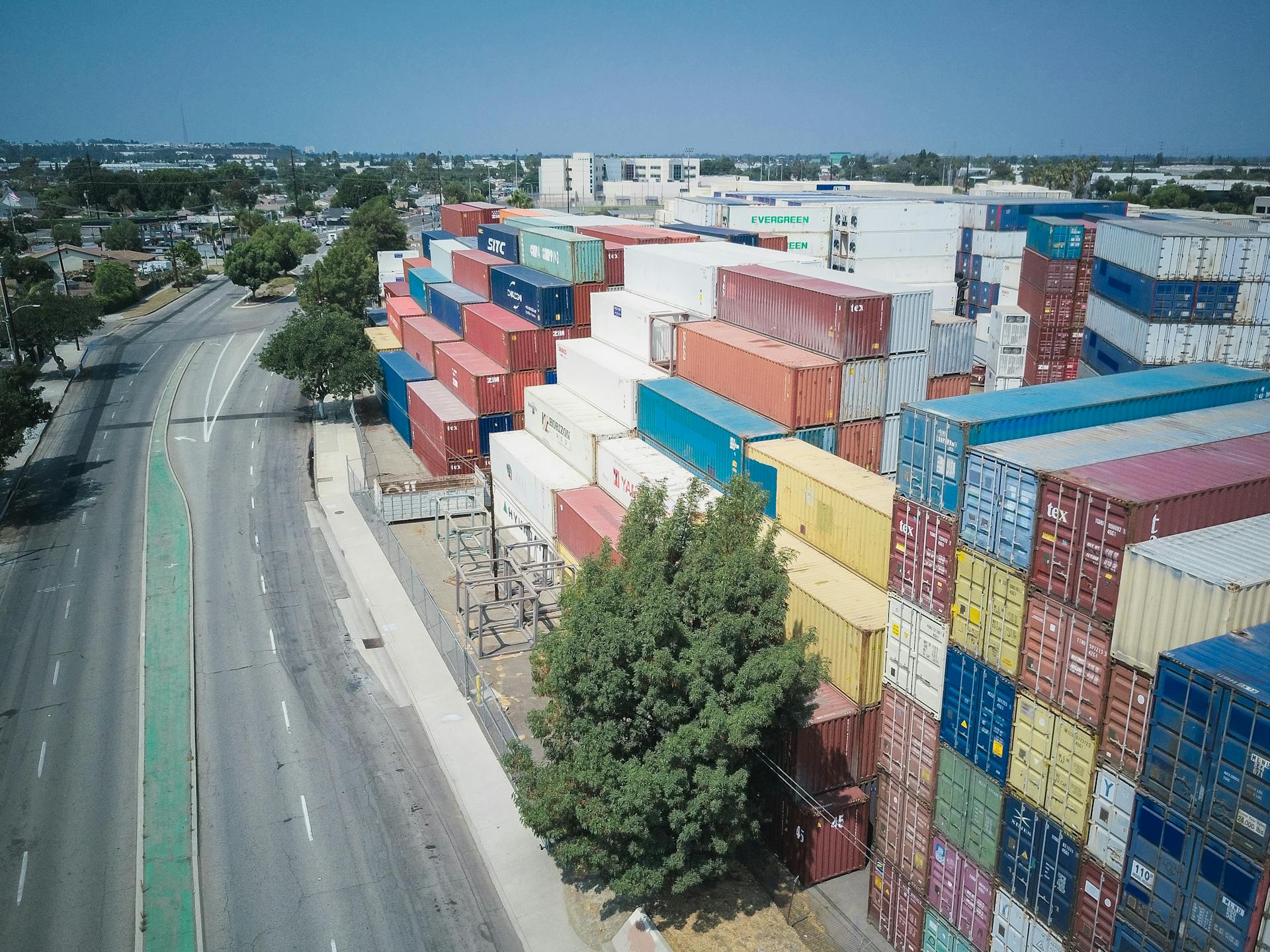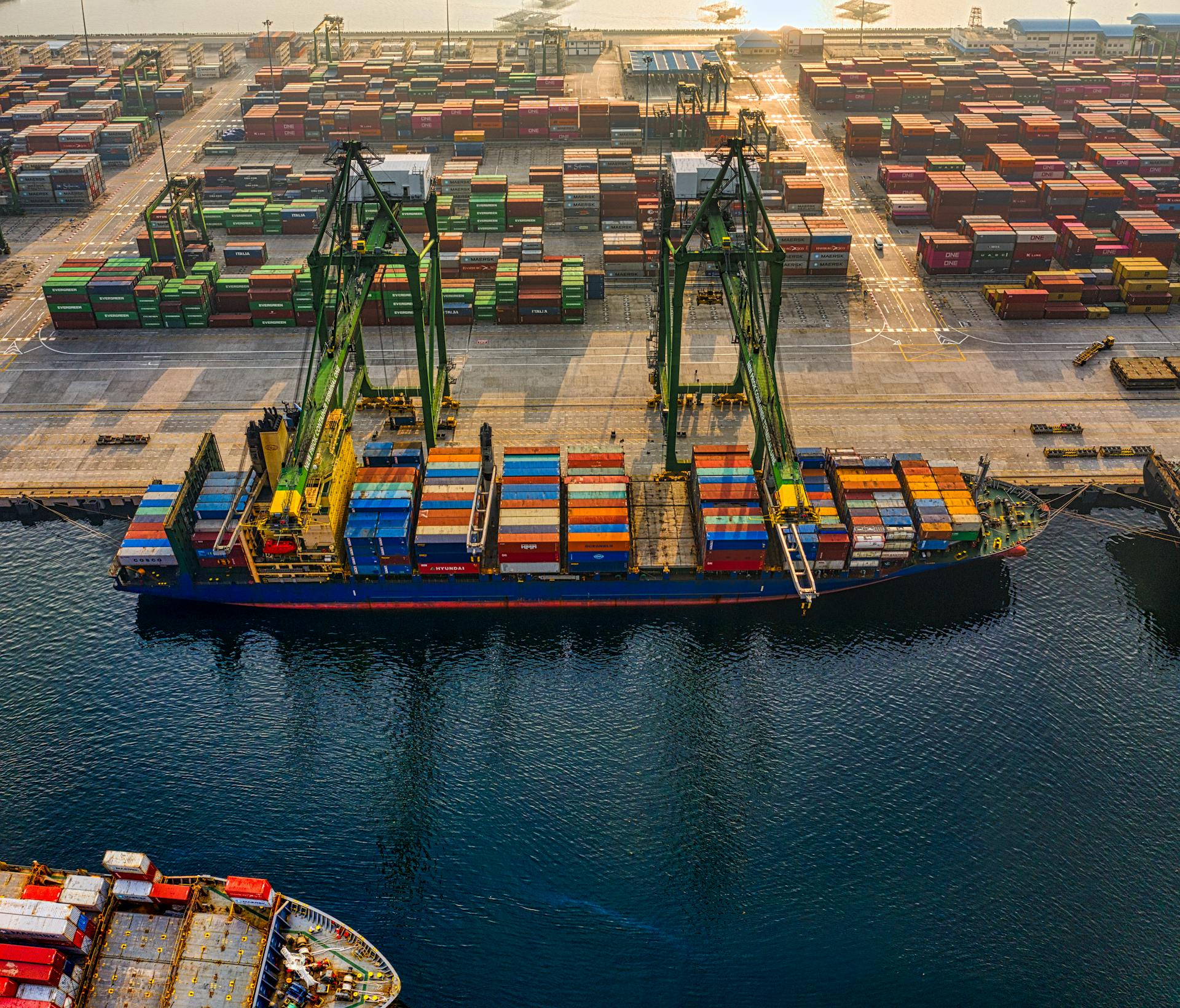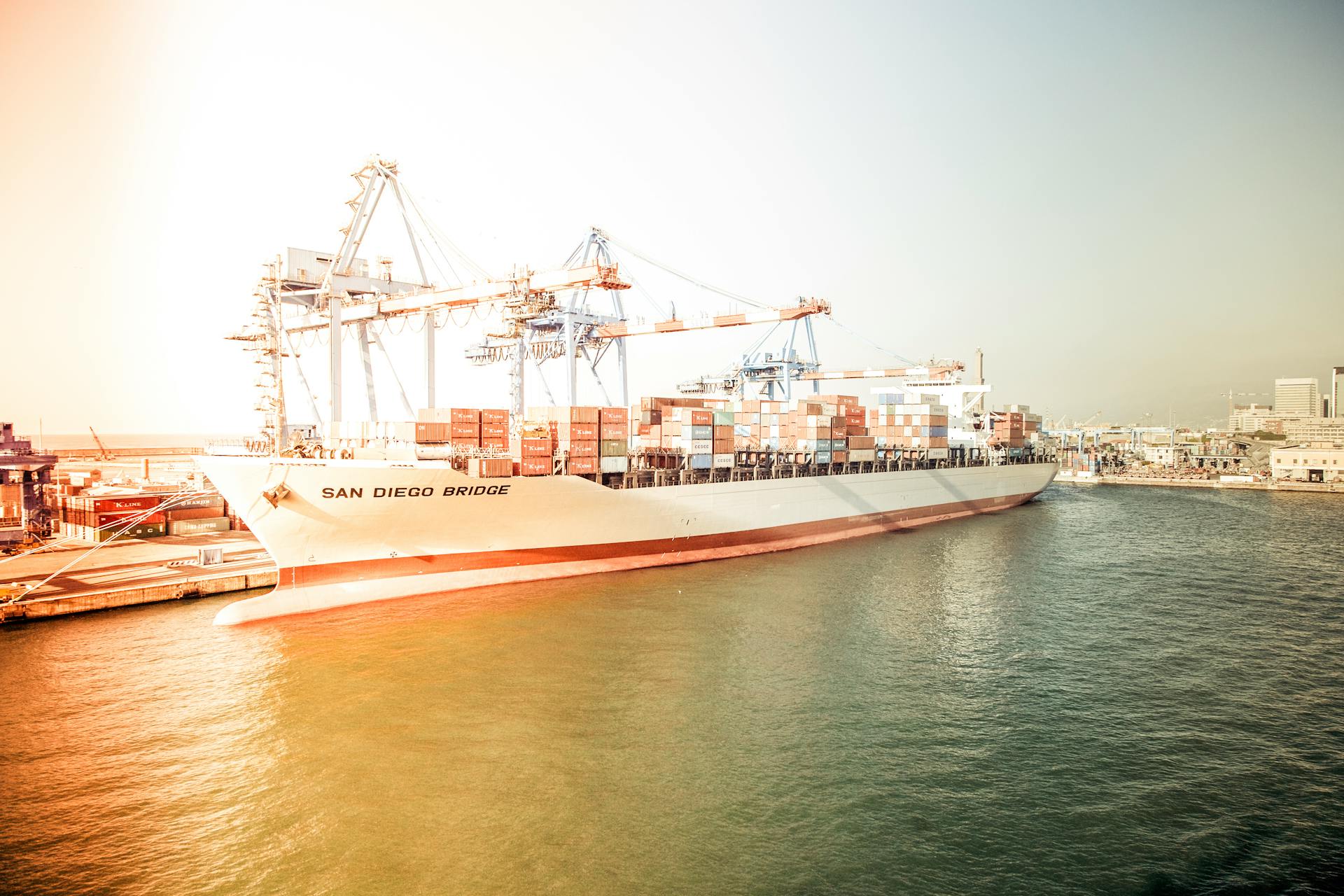
Ship hold cargo handling is a complex process that requires careful planning and execution. Ship holds are typically divided into compartments, with each compartment designed to handle a specific type of cargo.
A ship's cargo handling system typically includes cranes, winches, and conveyor belts to move cargo around the hold. This equipment is often powered by electric motors or hydraulic systems.
Proper cargo stowage is crucial to prevent damage to the cargo and the ship itself. Ship holds are designed with specific stowage requirements in mind, including the type of cargo, its weight, and its dimensions.
A different take: Ship Handling
Ship Hold Overview
A ship hold is essentially a large storage space within a ship, designed to carry goods and cargo. It's often located in the lower decks of the vessel.
Ship holds can be categorized into different types, including general cargo holds, tank holds, and refrigerated cargo holds. The size and layout of a ship hold can vary greatly depending on the type of cargo it's designed to carry.
Explore further: Port Canaveral Holds Maiden Voyage of New Royal Caribbean Ship

A typical general cargo hold can range in size from 10,000 to 50,000 cubic meters. The hold's layout is usually designed to maximize storage space and facilitate easy loading and unloading of cargo.
Refrigerated cargo holds, on the other hand, are equipped with cooling systems to maintain a specific temperature range. This is crucial for transporting perishable goods, such as food and pharmaceuticals.
The cargo holds are usually accessed through hatches, which are large openings in the ship's deck. These hatches are designed to allow cargo to be loaded and unloaded quickly and efficiently.
A ship's cargo holds are typically ventilated to maintain a safe and healthy environment for the crew and cargo. This is especially important for cargo holds that carry perishable or hazardous materials.
Cargo Management
Effective cargo management is crucial for the efficient operation of a ship hold. It involves the careful planning and execution of cargo loading, stowage, and unloading to ensure safe and secure transportation.
Cargo should be loaded in a way that allows for even weight distribution and minimizes the risk of shifting during transit. This is particularly important for ships carrying heavy or oversized cargo.
Ship operators often use specialized equipment, such as cranes and forklifts, to facilitate cargo loading and unloading.
Cargo Hatch

A cargo hatch is a type of door used on ships and boats to cover the opening to the cargo hold or other lower part of the ship. It's essential to keep the cargo hold waterproof, so most cargo holds have a cargo hatch.
The cargo hatch can be a waterproof door, like a trap door with hinges, or a cover that's placed on top of the cargo hold opening and held down with a tarp or latching system. Some cargo hatches are even flexible and roll up onto a pole.
A small cargo hatch to a small storage locker is called a Lazarette. If a cargo hatch fails in a storm, the ship is at risk of sinking, as happened with several bulk carrier hatches.
Most cargo hatches have a coaming, a raised edge around the hatch, to help keep out water. This is crucial in preventing water from entering the cargo hold.
There are different types of cargo hatches, including:
- Lifting (up to remove)
- Rolling (rolls up onto a pole, trap type)
- Folding (folds up like paper or an accordion)
- Sliding (slides onto the deck or over the side of ship)
- Roll stowing (rolls up onto a pole, plates)
Cargo Images

Cargo Images play a crucial role in cargo management, providing a visual representation of the goods being transported.
There are over 2,000+ ship cargo hold stock photos and images available, showcasing various types of cargo, such as grain, natural mineral fertilizers, and refined sugar.
Aerial views of cargo ships in commercial ports and seaports demonstrate the efficiency of loading and unloading operations.
Bulk carriers are often used to transport large quantities of grain, with some ships loaded to the brim with grain, as seen in aerial top views of cargo vessels in seaports.
Cargo ships can be loaded with a variety of goods, including tree logs, as seen in a cargo ship loaded with tree logs in Port Chalmers, Dunedin, Otago, New Zealand.
The spacious cargo holds of bulk carriers can accommodate large machinery, such as cherry pickers, which are used for maintenance and loading activities.
A pirate ship wooden deck illustration features a hold entrance, mast with ropes, and a buccaneer flag, highlighting the importance of cargo holds in maritime transportation.
Grain elevators can fill cargo holds quickly, as seen in a grain elevator filling the hold with wheat in bulk.
Cargo delivery and shipping operations involve loading goods from storage warehouses to seaports, as demonstrated by a picture of a storage facility with shelves and goods.
For another approach, see: Large Pallets
Regulations and Compliance

Employees have the right to refuse dangerous work if they believe it presents a danger. This is a crucial aspect of maintaining a safe working environment in ship holds.
To ensure compliance with regulations, it's essential to put in place safety procedures for entering and working in cargo holds. This includes providing training to employees on cargo holds hazards and safe work procedures.
Collaboration is also key in cargo operations. This involves working with all individuals involved, including shippers and receivers, to ensure everyone is aware of safety procedures and safety data sheets for the cargo.
To stay compliant, employees should be aware of the required safety equipment for cargo holds and know the hazards associated with cargo operations. They should also be familiar with their workplace's hazard prevention program.
Legislative Requirements
In Canada, employers have a responsibility to protect the health and safety of employees and anyone granted access to the workplace.

Employers must assess, identify, and prevent workplace hazards to all types of cargo, and establish and maintain a Hazard Prevention Program.
They must also put in place preventative measures, such as personal protective equipment, and provide training to employees related to safety procedures for all types of cargo.
This includes assessing cargo holds to determine if they are a confined space, and reassessing when any changes occur.
Employers must provide proof of the assessment to a Transport Canada Health and Safety Officer, or the cargo holds will be considered a confined space.
Here are some specific legislative requirements employers must follow:
- Assess cargo holds to determine if they are a confined space
- Reassess cargo holds when any changes occur
- Provide proof of the assessment to a Transport Canada Health and Safety Officer
Elimination and Prevention
Elimination and Prevention is a crucial aspect of Regulations and Compliance. It's all about making sure you're not putting yourself or others in harm's way.
To start, you need to determine if cargo holds are a confined space and if any future changes could create a hazard. This might seem obvious, but it's essential to know the risks involved.

You should also put in place safety procedures for entering and working in cargo holds. This includes providing training to employees on cargo holds hazards and safe work procedures.
It's not just about the employees, though – you need to work in collaboration with all individuals involved with cargo operation. This includes knowing safety procedures and safety data sheets for the cargo.
Using the required safety equipment for cargo holds is also a must. And, of course, knowing the hazards with cargo operations and your workplace's hazard prevention program is vital.
Here are some key steps to follow:
- Determine if cargo holds are a confined space and if any future changes could create a hazard.
- Put in place safety procedures for entering and working in cargo holds.
- Provide training to employees on cargo holds hazards and safe work procedures.
- Have rescue equipment in place.
Remember, employees have the right to refuse dangerous work if they believe it presents a danger.
Frequently Asked Questions
What is a hold on a ship?
A hold on a ship is a large compartment used for storing cargo, provisions, and equipment. It's a crucial part of a vessel's design, with modern ships featuring specialized holds for refrigerated goods and heavy-duty cargo.
How many 40ft containers does a ship hold?
A modern cargo ship can hold up to 12,000 40-foot containers. This is equivalent to 6,000 standard 20-foot containers.
What is a synonym for ship hold?
A synonym for ship hold is a cargo area or storage area.
Sources
- https://en.wikipedia.org/wiki/Hold_(compartment)
- https://clubpenguinjourney.fandom.com/wiki/Ship_Hold
- https://www.istockphoto.com/photos/ship-cargo-hold
- https://www.wikiwand.com/en/articles/Hold_(compartment)
- https://www.canada.ca/en/employment-social-development/services/health-safety/prevention/cargo-holds.html
Featured Images: pexels.com


